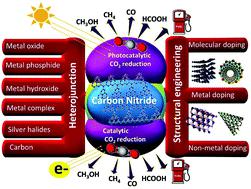当前位置:
X-MOL 学术
›
Green Chem.
›
论文详情
Our official English website, www.x-mol.net, welcomes your feedback! (Note: you will need to create a separate account there.)
Engineering graphitic carbon nitride (g-C3N4) for catalytic reduction of CO2 to fuels and chemicals: strategy and mechanism
Green Chemistry ( IF 9.3 ) Pub Date : 2021-06-18 , DOI: 10.1039/d1gc01303c Qingqing Lu 1, 2, 3, 4, 5 , Kamel Eid 6, 7, 8, 9, 10 , Wenpeng Li 1, 2, 3, 4, 5 , Aboubakr M. Abdullah 8, 9, 10, 11 , Guobao Xu 5, 12, 13, 14, 15 , Rajender S. Varma 16, 17, 18, 19
Green Chemistry ( IF 9.3 ) Pub Date : 2021-06-18 , DOI: 10.1039/d1gc01303c Qingqing Lu 1, 2, 3, 4, 5 , Kamel Eid 6, 7, 8, 9, 10 , Wenpeng Li 1, 2, 3, 4, 5 , Aboubakr M. Abdullah 8, 9, 10, 11 , Guobao Xu 5, 12, 13, 14, 15 , Rajender S. Varma 16, 17, 18, 19
Affiliation

|
The reduction of carbon dioxide to useful fuels/chemicals, such as methane, formic, and methanol, is an innovative way to address looming energy and environmental issues. Graphitic carbon nitride (g-C3N4), as a greener and low-cost catalyst for the electrocatalytic and photocatalytic carbon dioxide reduction reaction (CO2RR) to provide usable fuels, is endowed with numerous appealing attributes, e.g., Earth-abundant resources, facile synthesis, metal-free nature, catalytic properties, and unique thermal-physical–chemical stability. Articles on the use of g-C3N4 for CO2 transformation have increased significantly in the past decade, and it is important to provide timely updates in this emerging and active research area. This review emphasizes the rational structural engineering of g-C3N4, including doping (i.e., metal, non-metal, and molecular) and heterojunction formation (i.e., metal, metal oxide, metal phosphide, metal hydroxide, metal complex, Ag-halides, and carbon materials) for electrocatalytic, photoelectrocatalytic, and photocatalytic CO2RR. Besides, an in-depth deciphering of the CO2RR mechanism from experimental, theoretical, and fundamental concepts is provided, including deliberation on the sources/emission and strategies to avoid/reduce CO2 emission. Lastly, a brief conclusion and outlook on the challenges and future prospects are highlighted to assist further in the rational design of the g-C3N4-based catalyst as a selective and efficient catalyst for the CO2RR.
中文翻译:

用于将 CO2 催化还原为燃料和化学品的工程石墨氮化碳 (g-C3N4):策略和机制
将二氧化碳还原为有用的燃料/化学品,例如甲烷、甲酸和甲醇,是解决迫在眉睫的能源和环境问题的创新方法。石墨氮化碳 (gC 3 N 4 ) 作为一种更环保、成本更低的催化剂,用于电催化和光催化二氧化碳还原反应 (CO 2 RR) 以提供可用燃料,具有许多吸引人的属性,例如地球上丰富的资源,易于合成,无金属性质,催化性能和独特的热物理化学稳定性。关于使用 gC 3 N 4处理 CO 2 的文章在过去十年中,转型显着增加,重要的是在这个新兴和活跃的研究领域提供及时的更新。本综述强调了 gC 3 N 4的合理结构工程,包括掺杂(即金属、非金属和分子)和异质结形成(即金属、金属氧化物、金属磷化物、金属氢氧化物、金属配合物、卤化银)和碳材料)用于电催化、光电催化和光催化 CO 2 RR。此外,对 CO 2的深入破译提供了来自实验、理论和基本概念的 RR 机制,包括对源/排放的审议以及避免/减少 CO 2排放的策略。最后,强调了对挑战和未来前景的简要结论和展望,以进一步帮助合理设计基于gC 3 N 4的催化剂作为 CO 2 RR的选择性和高效催化剂。
更新日期:2021-07-16
中文翻译:

用于将 CO2 催化还原为燃料和化学品的工程石墨氮化碳 (g-C3N4):策略和机制
将二氧化碳还原为有用的燃料/化学品,例如甲烷、甲酸和甲醇,是解决迫在眉睫的能源和环境问题的创新方法。石墨氮化碳 (gC 3 N 4 ) 作为一种更环保、成本更低的催化剂,用于电催化和光催化二氧化碳还原反应 (CO 2 RR) 以提供可用燃料,具有许多吸引人的属性,例如地球上丰富的资源,易于合成,无金属性质,催化性能和独特的热物理化学稳定性。关于使用 gC 3 N 4处理 CO 2 的文章在过去十年中,转型显着增加,重要的是在这个新兴和活跃的研究领域提供及时的更新。本综述强调了 gC 3 N 4的合理结构工程,包括掺杂(即金属、非金属和分子)和异质结形成(即金属、金属氧化物、金属磷化物、金属氢氧化物、金属配合物、卤化银)和碳材料)用于电催化、光电催化和光催化 CO 2 RR。此外,对 CO 2的深入破译提供了来自实验、理论和基本概念的 RR 机制,包括对源/排放的审议以及避免/减少 CO 2排放的策略。最后,强调了对挑战和未来前景的简要结论和展望,以进一步帮助合理设计基于gC 3 N 4的催化剂作为 CO 2 RR的选择性和高效催化剂。
















































 京公网安备 11010802027423号
京公网安备 11010802027423号